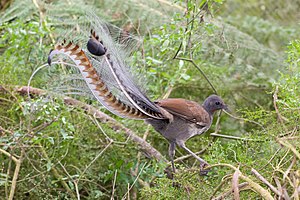Menura novaehollandiae
| Superb lyrebird | |
|---|---|
 |
|
| Scientific classification | |
| Kingdom: | Animalia |
| Phylum: | Chordata |
| Class: | Aves |
| Order: | Passeriformes |
| Family: | Menuridae |
| Genus: | Menura |
| Species: | M. novaehollandiae |
| Binomial name | |
|
Menura novaehollandiae Latham, 1801 |
|
The superb lyrebird (Menura novaehollandiae) is an Australian songbird, one of two species from the family Menuridae. It is one of the world's largest songbirds, and is noted for its elaborate tail and excellent mimicry. The species is endemic to the south east of the country, and has been introduced to Tasmania.
The superb lyrebird is featured on the reverse side of the Australian 10 cent coin.
An Australian endemic, the superb lyrebird can be found in the forests of south-eastern Australia, from southern Victoria to south-eastern Queensland. Its diet consists mainly of small invertebrates found on the forest floor or in rotting logs. In the 1930s a small number were introduced to Tasmania amongst ill-founded fears it was in danger of becoming extinct. The Tasmanian population is currently thriving. Now widespread and common throughout its large range, the superb lyrebird is evaluated as being of least concern on the IUCN Red List of Threatened Species.
The superb lyrebird is a pheasant-sized Australian songbird, with males measuring approximately 100 cm (39 in) long and females measuring 76 to 80 cm (30–31 in). Males weigh around 1.1 kg (2.4 lb), and females 890 g (1.96 lb). Among all extant songbirds only the common and thick-billed ravens regularly outweigh it and only the much more slender black sicklebill can rival its length. The plumage is brownish grey on upper body with a red-brown wash on the coverts and wings. The underparts are greyish-brown below. The wings are round and short, with a wingspan of 68 to 76 cm (27–30 in), and they are only capable of weak flight. The legs and feet are long and strong, and capable of running quickly on the ground and digging for food. The ornate tail of the male is 55 to 70 cm (22–28 in) long, and has sixteen feathers, with the two outermost together forming the shape of a lyre. Next within are two guard plumes and twelve long, lace-like feathers, known as filamentaries. Seven years are required for the tail to fully develop. During courtship displays, the male inverts his tail over his head, fanning his feathers to form a silvery white canopy. Young males and females have brown tail feathers which are camouflaged against the forest floor.
...
Wikipedia

